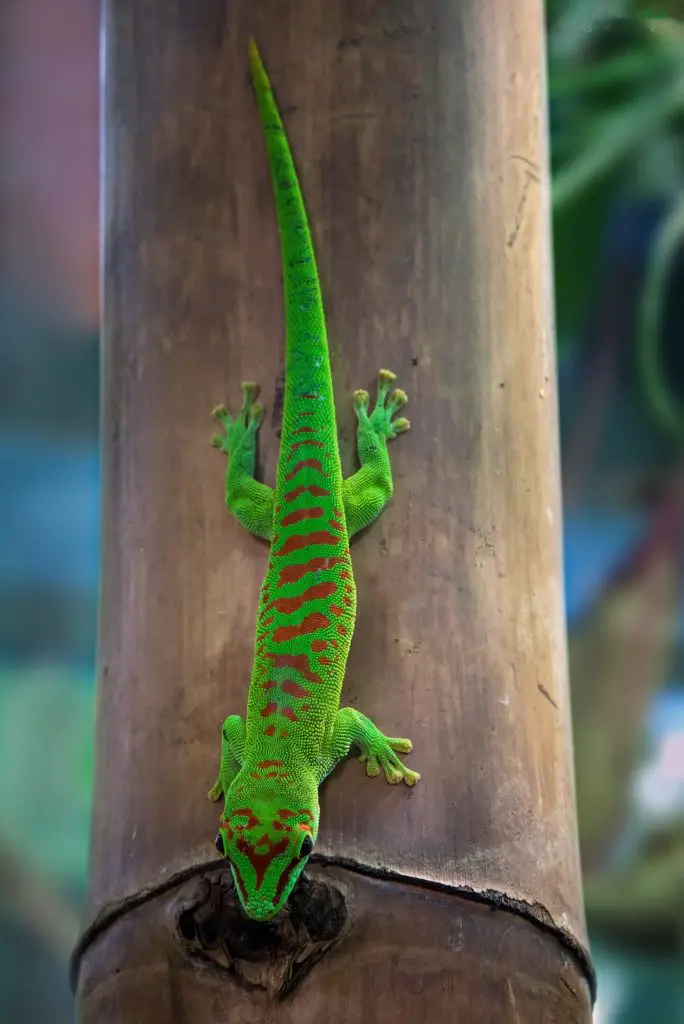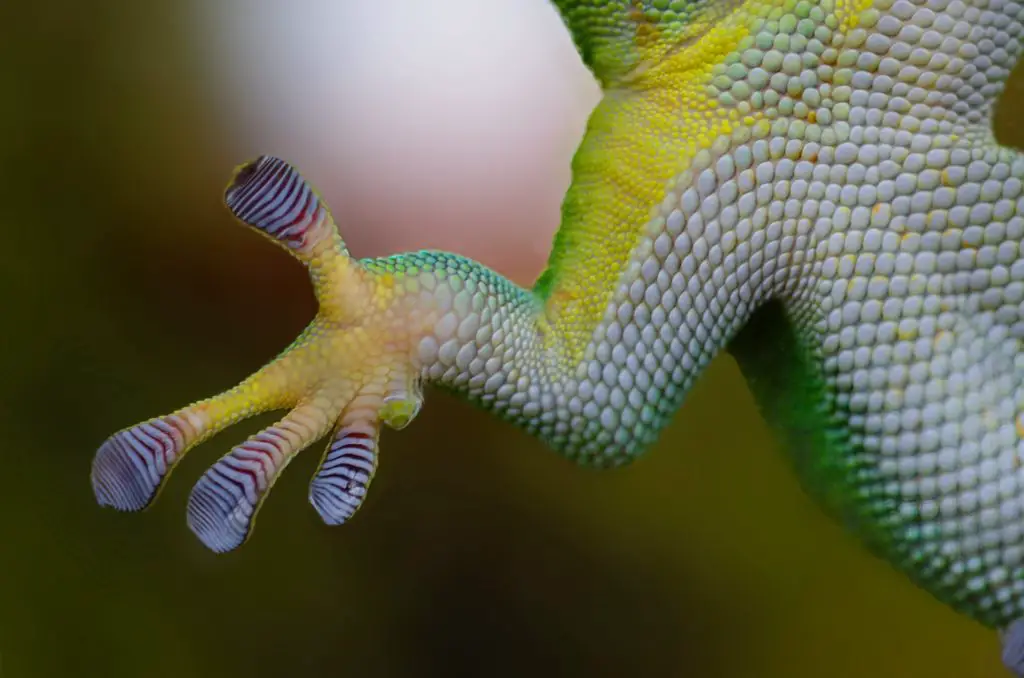Have you ever wondered how geckos do climb on everything? Well, I have because I own a pet gecko. Seeing him upside down always makes me wonder what their feet have. Geckos can stick in walls, glasses, skin, and they can even walk upside down. They hold on surfaces that are very hard to stick to. This is amazing when you think about it. To take care of my curiosity, I decided to do some research on geckos feet.
Here is what I found out.
How do geckos climb on everything?
The secret behind their sticky legs is the tiny microscopic hairs on their toes. These hairs are known as setae. All the setae split into other hundreds of smaller hairs known as spatulae. These tiny hairs come really close to the contours on the ceilings and walls, and this is where the force of attraction known as Van der Waals comes in. These are what helps the geckos defy the laws of gravity.
I came to understand that they do struggle to stick on dirty surfaces as compared to clean surfaces. Something I found fascinating is that they can turn on their stickiness and off when they want to. Geckos can walk very easily on the skin, but if you tried to pick him from your skin, they turn on their stickiness, and their feet adhere to your skin. Their legs are dry and when they walk on your skin, they won’t leave traces of sticky glue or something like that. Stay tuned to understand well how the geckos manage to stay upside down on walls. Read also what do geckos eat?
How Do Geckos Walk On Ceilings?
Like I mentioned earlier, the geckos have small hairs known as setae and even smaller hairs known as spatulae. As the gecko takes a step, the tiny hairs on their feet get close to the contours on the ceiling then they are held together by van der Waals force. This happens when the electrons on the hairs of the geckos’ feet are attracted to the electrons on the ceilings. An electromagnetic force is created. The geckos can control their stacking ability as fast as possible and whenever they want to. In the next paragraph, I will let you know how they manage their sticking ability.
How Do Geckos Climb On Glass?
Climbing on surfaces requires taking steps after steps. Geckos do climb on surfaces easily and as fast as they want. So how do they do it? From what I learned, the tiny hairs on their feet can be angled in different directions. They can balance the force of attraction by angling the tiny hairs. That way, they can stick and unstick anytime. For them to unstick, they curl their feet away from the wall to break the 90-degree angle that the seta makes with the walls. Geckos are not sticky. For them to stick on walls, they have to do something to become sticky. What makes it possible is the flexibility, angling, and extensibility of the hairs on their feet.
How Do Geckos Stick To Walls?
 By now, you understand how geckos stick on walls. It is made possible by the microscopic hairs on their feet. Some researchers tried to understand how the forces work and also the angling of the strands. They realized that the setae do branch out at different angles. When the hairs bend to an angle close to the horizontal, the geckos can support more weight and the surface area to which they can stick to increases. These researchers also realized that these setae are very flexible. This is the reason why geckos can change their directions very fast as they try to escape their predators. Also, as they jump from one surface to another, these hairs absorb the energy and redirect it. That way, the geckos can stick and walk easily at any angle. Redirecting the energy is made possible by the flexibility of the setae.
By now, you understand how geckos stick on walls. It is made possible by the microscopic hairs on their feet. Some researchers tried to understand how the forces work and also the angling of the strands. They realized that the setae do branch out at different angles. When the hairs bend to an angle close to the horizontal, the geckos can support more weight and the surface area to which they can stick to increases. These researchers also realized that these setae are very flexible. This is the reason why geckos can change their directions very fast as they try to escape their predators. Also, as they jump from one surface to another, these hairs absorb the energy and redirect it. That way, the geckos can stick and walk easily at any angle. Redirecting the energy is made possible by the flexibility of the setae.
Do Geckos Stick To Your Skin?
Yes, geckos stick very quickly to skins. They can stick to surfaces that are very hard to stick to. The only time they find it hard to stick to surfaces is when the surface is wet or dirty. When your skin is moist, setae that are extra-long and extra flexible will tangle for which case the geckos’ slides and may fall off. All they have to do to stick to your skin is to make sure that their sets are angled at 90 degrees to the molecules of your skin. To detach themselves from the surface, they have to break the 90-degree angle.
Leopard Gecko Feet
A leopard gecko feet are just like any other geckos feet. They can stick on walls, walk on ceilings, walk-on skin, and stick on any surface. The idea behind this is love for the water, a condition known as hydrophilia. The geckos are believed to have a thin layer of water on their feet. When the thin layer of water comes into contact with the surface, which should be hydrophilic, the generate a force of attraction. This force of attraction is enough to stick the geckos onto the surface. This force is a cohesive force where the molecules of the same kind attract each other. Since the geckos have bare legs, they take advantage of the moisture in the air. This is just one view of the researchers. The other view took the Van der Waals force direction. I think both views make sense unless they are proven otherwise. These views should also be the reason for the crested gecko sticky feet.
How Do Geckos Reproduce?
Geckos reproduce by mating, The male gecko holds the skin of the female gecko on his necks and wrap his tail around the female tail bringing their mating organs together. Some other species of gecko reproduce by laying eggs without the help of the male.
Where Do Geckos Live?
Most sticky geckos live in humid areas, which increases the stickiness.
Geckos climbing feet is the reason why they can climb on surfaces while you cannot. Researchers have who worked on this idea of climbing feet and have developed some technology to sealing of wound without stitching and some nanotechnology to develop sticking gloves that resemble use the sticking idea of geckos. This will help soldiers walk on walls someday.
To conclude
Geckos feet specifically help them climb on surfaces without falling off. This is made possible by the tiny hairs known as setae found on their feet. These sets are flexible enough to help the geckos to make abrupt turns and stick when they jump. The flexibility helps the geckos to redirect the energy built up. Some researchers have worked on developing biomimicry technology. The idea behind this being the functioning of gecko’s feet. They are also working on a technology to seal wounds without stitching. I think the idea behind this should be the attraction of molecules of the same kind. Check out our blog on what to feed a pet turtle.
If you like the content, save this pin in your gecko board or other pet-related board on Pinterest.



